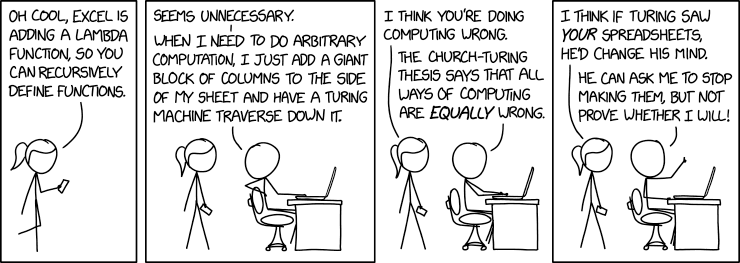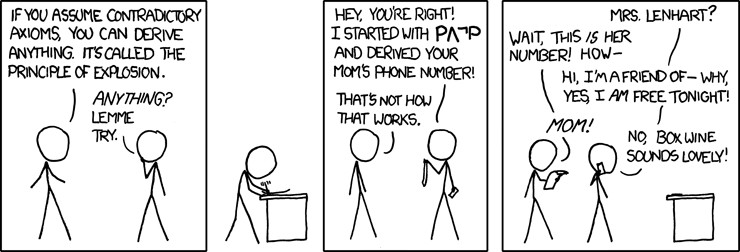Three-Valued Logic in the λ-Calculus
January 2023
Abstract. We define our three logical values in a similar fashion to the Church-encoding of booleans:
- $\mathbf{T} := \lambda xyz.x$
- $\mathbf{F} := \lambda xyz.y$
- $\mathbf{X} := \lambda xyz.z$
And these are some common logical connectives:
| Connective | Implementation |
|---|---|
| Negation | $ \neg x := x\mathbf{F}\mathbf{T}\mathbf{X}$ |
| Conjunction | $x\land y := xyx(y\mathbf{X}\mathbf{F}\mathbf{X})$ |
| Disjunction | $x\lor y := x\mathbf{T}y(y\mathbf{T}\mathbf{X}\mathbf{X})$ |
| Łukasiewicz implication | $x\to y := xy\mathbf{T}(y\mathbf{T}\mathbf{X}\mathbf{T})$ |
| Kleene implication | $x\to y := \neg x \lor y$ |
What is ternary logic?
The logic most of us are deeply familiar with is the two-valued, true-or-false, boolean logic. This is because it is the simplest and most intuitive logic, having been directly formulated based on human intuition. As a result, it carries with it some of the difficulties with our intuitions of truth. For instance, classical logic requires a sentence to be either true or false, lest every sentence be counted as true. This is known as the principle of explosion.
Theorem (Principle of explosion). If $P$ and $\neg P$ are true, then all sentences $Q$ are true. Otherwise stated as $\forall Q, (P \land \neg P) \to Q$.
Proof. Since $P$ is true, then $P \lor Q$ is true for all propositions $Q$. But since we have $\neg P$, then $Q$ must be true. For instance:
- Snow is white and snow is black; $P \land \neg P$.
- Snow is white or you're mother's number is 905-764-6464; $P \lor Q$.
- Snow is black; $\neg P$.
- Therefore, you're mother's number is 905-764-6464; $Q$.
The xkcd comic above is a little bit misleading. If your system is contradictory, then everything is your mom's phone number! A contradictory system predicts that if you dial "what's the difference between an enzyme and a hormone," then your mother will pick up the phone, as well as Aristotle—who will surely be mad at you for letting a contradiction slip into your system. To avoid such a confrontation, some logicians have invented logical systems which do not allow this dreaded possibility. These are called paraconsistent logics, and (some) three-valued logics are of this type.
The way ternary logic deals with the principle of explosion is by introducing a third value—$\mathbf{X}$, meaning both true and false—besides the usual true and false. Then by cleverly defining the usual logical relations, we can obtain a logic which allows its user to have contradictory notions without being punished by Aristotle. The one being shown here is Kleene-Priest1 incantation. Firstly, we allowed $\mathbf{T}$ and $\mathbf{X}$ to be designated values. That is, we are allowed to use a sentence for further deduction if its truth-value is either $\mathbf{X}$ or $\mathbf{T}$. Then we define the common logical relations as follows:
| $\mathbf{T}$ | $\mathbf{X}$ | $\mathbf{F}$ | |
| $\mathbf{T}$ | $\mathbf{T}$ | $\mathbf{X}$ | $\mathbf{F}$ |
| $\mathbf{X}$ | $\mathbf{T}$ | $\mathbf{X}$ | $\mathbf{X}$ |
| $\mathbf{F}$ | $\mathbf{T}$ | $\mathbf{T}$ | $\mathbf{T}$ |
| $\mathbf{T}$ | $\mathbf{X}$ | $\mathbf{F}$ | |
| $\mathbf{T}$ | $\mathbf{T}$ | $\mathbf{T}$ | $\mathbf{T}$ |
| $\mathbf{X}$ | $\mathbf{T}$ | $\mathbf{X}$ | $\mathbf{X}$ |
| $\mathbf{F}$ | $\mathbf{T}$ | $\mathbf{X}$ | $\mathbf{F}$ |
| $\mathbf{T}$ | $\mathbf{X}$ | $\mathbf{F}$ | |
| $\mathbf{T}$ | $\mathbf{T}$ | $\mathbf{X}$ | $\mathbf{F}$ |
| $\mathbf{X}$ | $\mathbf{X}$ | $\mathbf{X}$ | $\mathbf{F}$ |
| $\mathbf{F}$ | $\mathbf{F}$ | $\mathbf{F}$ | $\mathbf{F}$ |
| $\mathbf{T}$ | $\mathbf{F}$ |
| $\mathbf{X}$ | $\mathbf{X}$ |
| $\mathbf{F}$ | $\mathbf{T}$
|
Well, how does this logic avoid the principle of explosion? Remember that the formal statement of that principle is $(P \land \neg P) \to Q$. For us to be able to make deductions based on this sentence, it would either have to be $\mathbf{T}$ or $\mathbf{X}$ for all possible values of $Q$. By looking at the table, we can see that the left side of the implication cannot be $\mathbf{T}$, because in that case then the implication wouldn't hold for all $Q$. So $P \land \neg P$ must either be $\mathbf{X}$ or $\mathbf{F}$. If it is $\mathbf{F}$, then it's nothing out of the ordinary—that's just plain ol' classical logic. However if it is $\mathbf{X}$, then—unlike classical logic—we may use $P \land \neg P$ in further deductions! Besides that, $P$ has to be $\mathbf{X}$, indicating that it is a paradoxical proposition!
This logic solves many problems such as the liar paradox. Though sadly it doesn't support modus ponens. Which is unfortunate because I really like modus ponens.
What is the λ-calculus?
The λ-calculus is a simple language capable of universal computation. I won't go into full detail about that here because it's been covered better else where2. For now I'll give a brief overview of the basics of the language and the encoding of booleans into it.

As I said before, the λ-calculus is a language invented by Alonzo Church way back in the 30s. Its interesting because it is capable of universal computation despite being incredibly simple. So simple that it only has two kinds of objects: symbols and functions. Symbols are just alphabetic characters like $x$ and $y$. Functions take the form of $\lambda x.M$. Where $x$ is the variable representing the input of the function and $M$ is the expression that results in the output. The λ-calculus also allows to apply any two expressions to each other, this is denoted by putting the two expressions next to each other, like $MN$. Symbol application is very uninteresting—$x$ applied to $y$ is just $xy$—and function application is what you would expect. When applying $\lambda x.M$ to $N$, you replace all instances of $x$ in $M$ by the expression $N$. For example, $(\lambda xy.x)(\lambda xy.y)$ is evaluated as follows: $$ \begin{aligned} (\lambda xy.x)(\lambda xy.y) &\to (\lambda xy.x)(\lambda pq.q) \text{\ notice how $\lambda pq.q$ is the same as $\lambda xy.y$.} \\ &\to x[\text{replace $x$ with $\lambda pq.q$}] \\ &\to \lambda pq.q \end{aligned} $$
In programming we make use of booleans quite a lot. And since this language doesn't provide them for us, we must implement them ourselves. The classic way that this is done is due to Alonzo Church. He started by noticing that there are only two functions that take two arguments and return one of them. So he defined his truth values as follows: $$ \begin{aligned} \mathbf{T} &:= \lambda xy.x, \\ \mathbf{F} &:= \lambda xy.y \end{aligned} $$ Then he went on and implemented the usual operations of conjunction, disjunction, negation, and implication. We'll also go through the process of deriving these. But the first thing you have to notice is that since $\mathbf{T}, \mathbf{F}$ are functions of two arguments, and the connectives are taking these as input, then the body of each connective is going to be three terms applied to each other. One for the input, the other for the case where the input is true, and the other for the case where the input is false.
Lets start with $\neg x$ first because it's the easiest. As we discussed before, the function probably looks like $\lambda x.xPQ$ for some $P$ and $Q$. Now there are two cases, either $x = \mathbf{T}$, or $x = \mathbf{F}$. If the first case is true, then we must return $\mathbf{F}$. So we must pick $P$ and $Q$ such that $\mathbf{T}PQ = \mathbf{F}$. Since $\mathbf{T}$ returns its first argument and ignores the second one, then we must let $P = \mathbf{F}$. Similarly, if $x = \mathbf{F}$, then $x\mathbf{F}Q = \mathbf{T}$. In this case, since $\mathbf{F}$ returns its second argument and ignores the first one, then $Q = \mathbf{T}$. So it should be clear that $\neg x := x\mathbf{F}\mathbf{T}$.
The derivation for $x \land y$ and $x \lor y$ are very similar to each other so I'll only go over disjunction. As before, it probably looks something like $\lambda xy.xPQ$. There are two cases for $x$, either $x = \mathbf{T}$, or $x = \mathbf{F}$. If it's the first one, then the disjunction is automatically true. So $P = \mathbf{T}$. If it's the second one, then the disjunction is valid if and only if $y = \mathbf{T}$. Therefore $Q = y$. As such $x \lor y := x\mathbf{T}y$.
I'm not going to go over implication because it's quite simple. You can either do it the same way we did the previous ones, or use the fact that $x \to y = \neg x \lor y$ and do the reduction yourself. In short, implication is $\lambda xy.xy\mathbf{T}$.
Implementing ternary logic in the λ-calculus
Implementing ternary logic in the λ-calculus isn't too different from implementing classical logic. The truth-values are implemented in a very similar fashion. $$ \begin{aligned} \mathbf{T} := \lambda xyz.x, \\ \mathbf{F} := \lambda xyz.y, \\ \mathbf{X} := \lambda xyz.z. \end{aligned} $$ As you can see, it's the exact same concept as the Church-encoding. There are only three functions of three arguments that return one of their arguments. As a consequence, the shape of the logical connectives are also quite similar. In booleans, each of them had a function body involving the application of three terms. Here, each body is the application of four terms: one of the arguments, the case where it is true, the case where it is false, and the case where it is both.
As with booleans, negation is the easiest to implement—its basically identical to the boolean version. But now we also have to consider the case where $x = \mathbf{X}$ in which case we just return $\mathbf{X}$. So $\neg x := x\mathbf{F}\mathbf{T}\mathbf{X}$.
Disjunction and conjunction are little bit more complicated than the boolean case. Lets deal with disjunction for now. As we know the function looks something like $\lambda xy.xPQR$. Now we have three cases for $x$:
- If $x = \mathbf{T}$, then the output is automatically true. So $P = \mathbf{T}$.
- If $x = \mathbf{F}$, then the output is the same as $y$—just like the boolean version. So $Q = y$.
- If $x = \mathbf{X}$, then the output is $\mathbf{X}$ unless $y = \mathbf{T}$, in which case it is $\mathbf{T}$. As such, $R$ is an expression in terms of $y$. By the same reasoning as above, we can assume that $R = yABC$. If $y = \mathbf{T}$, then $R = \mathbf{T}$. So $A = \mathbf{T}$. Otherwise, $R = \mathbf{X}$, so $B, C = \mathbf{X}$. Therefore $R = y\mathbf{T}\mathbf{X}\mathbf{X}$.
As such, $x \lor y := x\mathbf{T}y(y\mathbf{T}\mathbf{X}\mathbf{X})$. With the same procedure we can find the term of conjunction as well: $x \land y := xyx(y\mathbf{X}\mathbf{F}\mathbf{X})$. Kleene implication is just $\neg x \lor y$ so I didn't bother finding a term for that. I also did Łukasiewicz implication just because I could. The results can be found at the top of the page.
Priest's The Logic of Paradox is a great paper and he (obviously) goes into a lot more detail than I do here. So go read it.
Peter Selinger's lecture notes are probably the best place to start. Though my own notes aren't too bad either. In fact this post is the solution to one of the exercises in my notes.
